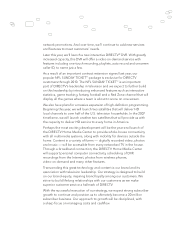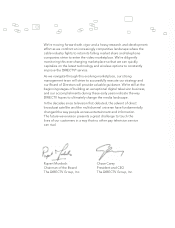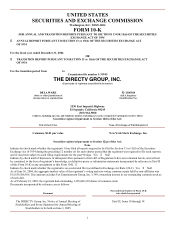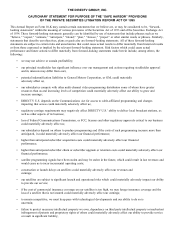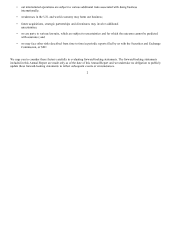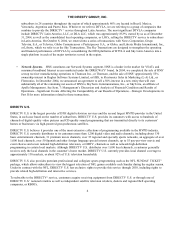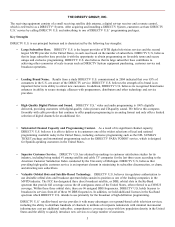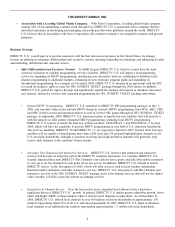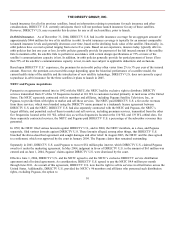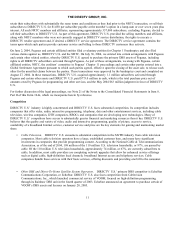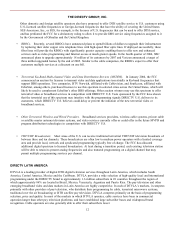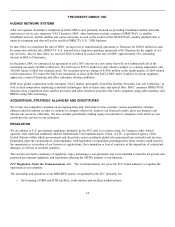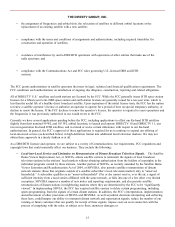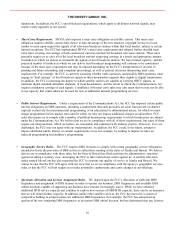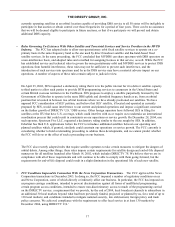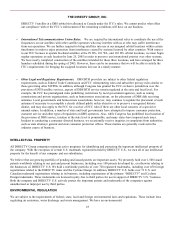DIRECTV 2004 Annual Report Download - page 17
Download and view the complete annual report
Please find page 17 of the 2004 DIRECTV annual report below. You can navigate through the pages in the report by either clicking on the pages listed below, or by using the keyword search tool below to find specific information within the annual report.
THE DIRECTV GROUP, INC.
•
Reduce Signal Theft. DIRECTV U.S. has undertaken and will continue to undertake various initiatives with
respect to its conditional access system to further enhance the security of the DIRECTV signal. To help combat
signal theft, DIRECTV U.S. is providing its customers with more advanced access cards that it believes
significantly enhance the security of the DIRECTV signal. In addition, DIRECTV U.S. continues to seek out and
prosecute signal thieves with its own internal efforts and with the support of local, state and federal law
enforcement agencies.
•
Enhanced Sales and Marketing, Customer Service and Distribution. DIRECTV U.S. also intends to drive
subscriber growth by continuing to expand its distribution while enhancing its sales and marketing along with
customer service.
•
Expand Distribution. While DIRECTV U.S. expects to maintain its strong relationships with its core retailers
and dealers, it also will continue to develop and strengthen its direct sales channels and strategic marketing
alliances with RBOCs, such as BellSouth, Verizon, Qwest and other telephone service providers. In addition,
DIRECTV U.S. expects to significantly improve its sales and distribution in the former National Rural
Telecommunications Cooperative, or NRTC, territories as a result of its purchase of the NRTC distribution rights
in the second half of 2004.
•
Enhance Sales and Marketing. DIRECTV U.S. expects to achieve continued strong subscriber growth through
aggressive marketing and promotion that will exploit the strength of the DIRECTV brand.
•
Improve Customer Service. DIRECTV U.S. expects to continue to focus on improving customer service in
2005. By selectively in-sourcing specific customer service functions, DIRECTV U.S. plans to assume more
accountability and control of its customers’ experiences. For example, in the second half of 2004, DIRECTV U.S.
opened two new owned and operated customer call centers. In 2005, DIRECTV U.S. plans to expand company
owned and operated call centers and continue to enhance telephone-based and web-based and self-care
capabilities. These additions are expected to enhance customer convenience and heighten overall customer
service.
Infrastructure
Satellites. DIRECTV U.S. currently uses a fleet of six satellites to broadcast its service from its 101 degrees west longitude, or
WL, 110 WL and 119 WL orbital locations. DIRECTV U.S. also broadcasts from 72.5 WL under its arrangement with Telesat
Canada, or Telesat, Industry Canada and the FCC. Additionally, DIRECTV U.S. broadcasts from 95 WL using transponders on
a satellite it leases. Most of DIRECTV U.S.’ programming is distributed from 101 WL.
The FCC licensed DIRECTV U.S. to operate 46 DBS frequencies at various orbital positions including 32 frequencies at the
101 WL orbital location, 11 frequencies at the 119 WL orbital location, and three frequencies at the 110 WL orbital location. In
the third quarter of 2004, DIRECTV U.S. obtained final approval from Industry Canada and the FCC to use the 72.5 WL orbital
location. As a part of DIRECTV U.S.’ arrangement with Telesat, DIRECTV U.S. transferred its DIRECTV 3 satellite, which
was previously used as an in-orbit spare, to the 82 WL orbital location for use by Telesat and relocated its DIRECTV 5 satellite
to the 72.5 WL orbital location, where it broadcasts its service using 16 frequencies.
Satellites Under Construction. DIRECTV U.S. currently has seven satellites under construction. DIRECTV 8, which is
expected to launch in the second quarter of 2005, will provide backup capacity at the 101 WL orbital location. DIRECTV 9S,
which is expected to launch in the first quarter of 2006, will provide backup capacity at the 101 WL and 119 WL orbital
locations.
In the third quarter of 2004, DIRECTV U.S. announced a plan to deploy five next-generation satellites. DIRECTV U.S. plans to
launch SPACEWAY 1 and SPACEWAY 2 by mid-2005, which will be used for DTH


